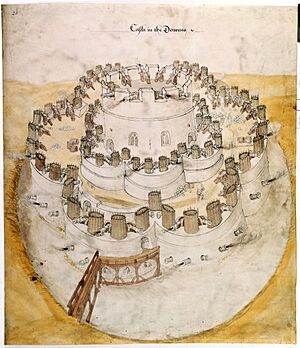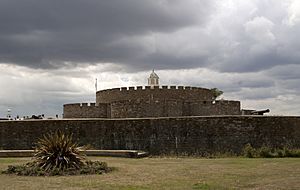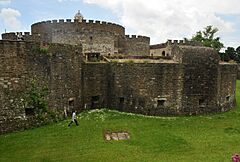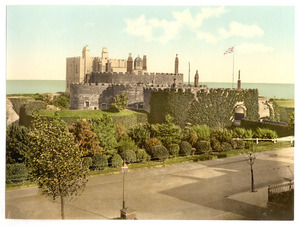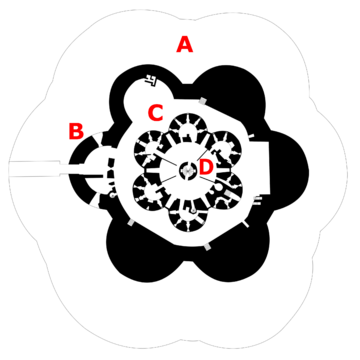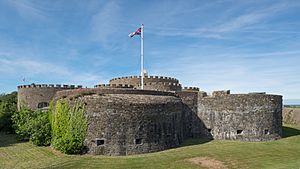Deal Castle facts for kids
Quick facts for kids Deal Castle |
|
|---|---|
| Deal, Kent | |
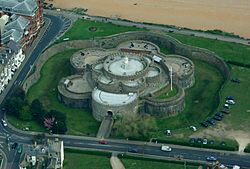
The castle viewed from the air
|
|
| Coordinates | 51°13′10″N 1°24′13″E / 51.21943°N 1.40356°E |
| Grid reference | TR 378 521 |
| Type | Device Fort |
| Site information | |
| Owner | English Heritage |
| Open to the public |
Yes |
| Condition | Intact |
| Site history | |
| Materials | Kentish ragstone, brick, Caen stone |
| Events | Second English Civil War, Second World War |
| Official name | Artillery castle at Deal |
| Designated | 9 October 1981 |
| Reference no. | 1013380 |
Deal Castle is a strong fort built by King Henry VIII in Deal, Kent. It was constructed between 1539 and 1540. This castle was part of the King's plan to protect England from possible invasions. At that time, there was a threat from France and a powerful empire. The castle helped defend the important Downs anchorage off the English coast.
Deal Castle has a central tower, called a keep, and six inner and outer rounded sections called bastions. It was surrounded by a moat and covered about 0.85 acres (0.34 hectares). The castle had 66 places for cannons. Building Deal Castle, along with two nearby castles, Sandown and Walmer, cost the King about £27,092. These three castles were close together and connected by earth walls.
The threat of invasion passed, but Deal Castle played a role in the Second English Civil War (1648–49). During this time, supporters of the King took control of the castle. However, forces loyal to Parliament later recaptured it after several months of fighting.
Over the years, the castle changed. In the 18th and 19th centuries, parts of it were made into a more comfortable home for the castle's captain. This job had become an honorary position. By 1904, the army decided the castle was no longer needed for defence. It was then opened to the public when the captain was not living there.
During the early part of the Second World War, German bombs destroyed the captain's living area. The castle then became a lookout point for an army gun battery along the coast. After the war, the castle was no longer used as a home. The government restored it in the 1950s to become a place for tourists to visit. Today, English Heritage looks after Deal Castle. In 2008, over 25,000 people visited the castle.
Contents
History of Deal Castle
Building the Castle (16th Century)
Why the Castle Was Built
Deal Castle was built because of problems between England, France, and a powerful empire during the last years of King Henry VIII's rule. Before this, local lords and communities usually handled coastal defences. The King had only a small role in building forts. While France and the empire were fighting each other, raids by sea were common. However, a full invasion of England seemed unlikely. Most defences were small, like simple blockhouses and towers.
In 1533, Henry VIII broke away from the Pope. He wanted to end his marriage to Catherine of Aragon and marry again. Catherine was the aunt of Charles V, the Holy Roman Emperor. He saw the annulment as a personal insult. Because of this, France and the Empire formed an alliance against Henry in 1538. The Pope encouraged them to attack England. An invasion of England seemed very likely. In response, Henry issued an order in 1539. This order, called a "device," gave instructions for defending England and building forts along the coast.
How Deal Castle Was Built
Deal Castle, along with Walmer and Sandown, was built to protect the Downs in east Kent. The Downs was an important place for ships to anchor, protected by the Goodwin Sands. It also gave access to Deal Beach, where enemy soldiers could easily land. The King knew this area well.
These stone castles were supported by four earth forts and a 2.5-mile (4 km) long defensive ditch and bank. Together, these defences were called the "castles of the Downes."
We don't know who designed Deal Castle. However, Sir Edward Ryngeley and Thomas Wingfield were in charge of the project. Work on Deal Castle started in April 1539 and moved quickly. By the next month, 1,400 men were working there. A strike for higher pay was stopped by Ryngeley during the summer. By December, the castle was mostly finished.
Deal Castle and the other forts along the Downs cost the King £27,092 to build. Much of this money came from the closing down of monasteries a few years earlier. Materials like lead, timber, and stone from local monasteries were also reused for Deal Castle.
Thomas Wingfield became the first captain of the castle in 1540. He had a lieutenant and oversaw a group of eight soldiers, sixteen gunners, and two porters. He reported to the Lord Warden of the Cinque Ports.
The original invasion threat passed. However, the castle was made stronger in 1558 because of new worries about a French attack. Around 1570, the main bastions were filled with earth. This was probably to allow heavier guns to be placed on them. Queen Elizabeth I visited the castle in 1573. The coastal defences were made ready in 1588 when the Spanish Armada threatened England. They likely stayed ready for action for the rest of Elizabeth's rule.
Deal Castle in the 17th Century
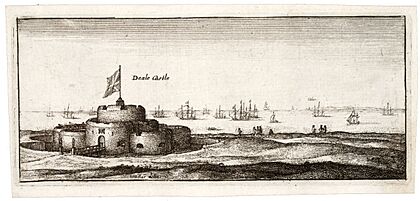
In the early 1600s, England was at peace, so coastal defences were not given much attention. By 1615, Deal Castle was in poor condition. Its outer walls were damaged by storms and sea erosion. A survey suggested repairs would cost about £396. The Captain of the castle, William Byng, wrote many letters. He said winter storms had filled the moat with water and stones, and damaged the castle's foundations. By 1618, he reported that most of the soldiers lived in the nearby town. Only a small guard stayed at the castle at night.
As the castle's condition worsened, fighting between Dutch, French, and Spanish ships in the Downs became common. This made the forts along the Kent coast more important. A new survey in 1624 estimated repairs would cost £1,243. Some repairs were probably done in the late 1630s.
At the start of the First English Civil War in August 1642, Parliamentary forces took control of the castle. William Batten replaced William Byng, who was thought to support the King. However, the castle played a small part in this first conflict.
When the Second English Civil War began in 1648, the Parliament's navy was in the Downs. It was protected by Walmer and the other castles. But by May, a Royalist uprising was happening across Kent. The previous year, Batten had been forced to leave his navy job. He now encouraged parts of the navy to switch sides. Walmer and Deal Castle declared their support for the King, soon after the soldiers at Sandown did the same.
Parliament defeated the wider uprising in June. Then, a force led by Colonel Nathaniel Rich was sent to deal with Deal and the other castles. Walmer Castle was attacked first and surrendered on July 12. Deal Castle, which had received supplies from the Royalists by sea, was attacked in July. A Royalist fleet fired cannons at the Parliament's positions. They also temporarily landed 1,500 soldiers from Flanders to help the revolt. But a lack of money forced these soldiers to return to Europe.
The castle's soldiers then launched a surprise attack on their attackers but were pushed back. The Royalist fleet, led by Prince Charles, tried to land more soldiers in August. Despite three attempts, the operation failed and suffered heavy losses. After news arrived of the Royalist defeat at Preston, Deal Castle surrendered on August 20. Artillery attacks then began on Sandown, leading the remaining soldiers there to surrender.
Nathaniel Rich became the new Captain. He reported that the castle was badly damaged during the fighting. He estimated repairs would cost at least £500. A governor, Samuel Taverner, was appointed with twenty soldiers. Because of the threat from the Dutch, Deal Castle was kept ready with gunpowder. It was strengthened with earthworks and soldiers at the start of the First Anglo-Dutch War in 1652.
After the King returned to power in 1660, the number of soldiers was reduced. However, the castle continued to defend the Downs during the Second and Third Anglo-Dutch Wars. In December 1688, during the Glorious Revolution, the people of Deal took control of the castle to support William of Orange. They prepared to defend the Downs against a feared invasion that never happened.
Deal Castle from the 18th to 21st Centuries
Deal Castle continued to be used by the military throughout the 18th century. In 1728, it had 11 large cannons. The next year, the captain, Sir John Norris, improved the castle to make his living area better. The central tower was redesigned with medieval-style battlements. It also had wood-panelled rooms at the back overlooking the sea.
During the Napoleonic Wars, the castle had nine 36-pounder cannons. More cannons were placed along the beach. To protect Deal, groups of soldiers called fencibles were formed in 1794. In 1802, soldiers recruited by William Pitt the Younger carried out military exercises at the castle. A politician named Lord Carrington also made improvements to the castle in 1802.
Deal Castle started to look more like a private house than just a fort. This led to arguments in 1829 about whether it should be taxed like a private home. The job of captain had become an honorary position, given as a reward by the King. In 1904, the army decided the castle was no longer useful for defence or as a barracks. It was then fully given to the Office of Works. When the captain was not living there, it was opened to visitors.
During the Second World War, in November 1940, German bombers destroyed much of the captain's living area. The captain, William Birdwood, had to move. Two large naval guns were placed in front of the castle between 1940 and 1944. The castle became a Battery Operating Post and provided accommodation. After Birdwood's death in 1951, the castle officially stopped being a home. It was then passed to the Ministry of Public Building and Works.
Restoration work was done in the 1950s. This removed most of the changes made in the 18th century on the side facing the sea. In 1972, the honorary captaincy of Deal Castle was brought back. General Sir Norman Tailyour was appointed, followed by Major General Ian Harrison in 1979. Since 2008, the Commandant General Royal Marines holds the captaincy.
Today, English Heritage manages Deal Castle as a tourist attraction. It is protected under UK law as a scheduled monument.
Architecture of Deal Castle
Deal Castle still has most of its original 16th-century design. It has a tall central tower, or keep, with six rounded bastions. These bastions are 86 feet (26 meters) across. Around the keep are another six rounded bastions. The western one served as the gatehouse. The entire castle is surrounded by a moat and an outer wall. The castle's bastion walls are 15 feet (4.6 meters) thick.
The castle was built using Kentish ragstone from near Maidstone, bricks made locally, and Caen stone. This stone was reused from local monasteries. Deal Castle was larger than its sister castles at Walmer and Sandown. It measured about 234 by 216 feet (71 by 66 meters) and covered 0.85 acres (0.34 hectares).
The castle originally had four levels for cannons. The heaviest and longest-range guns were on the upper levels, including the keep. In total, there were 66 firing positions for cannons. There were also 53 small openings in the basement for handguns, for close defence. The openings in the walls were wide to allow the guns to move easily. The inside of the castle had vents to let out the smoke from the guns. The battlements on the modern castle look like medieval ones, not Tudor, and were added in 1732.
Historians consider the original castle design to be a mix of older English styles and newer Italian defence styles. Like its sister castles, Deal had some design challenges. It needed too many guns to be fully equipped. Its curved surfaces were also vulnerable to attack. Even though efforts were made to keep the walls low and thick, its relatively high shape made it exposed to attacks.
You enter Deal Castle through the gatehouse. This gatehouse originally overlooked a walled garden, which is now mostly gone. The dry, stone-lined moat is 20 meters (66 feet) wide and 5 meters (16 feet) deep. It would have been crossed by a stone causeway and a drawbridge. Today, a modern wooden bridge replaces the drawbridge.
The gatehouse still has its original iron-studded doors. These are considered some of the best-preserved for their age. It also has five "murder-holes" that allowed the soldiers to defend the entrance with missiles or handguns. It would also have been protected by a portcullis at the entrance. The outer bastions were filled with earth in the 1570s and have 18th-century ramparts. A passage called "the Rounds" runs along the outside of the outer bastions. This passage connects the handgun positions that covered the base of the moat.
The central tower, or keep, has a central spiral staircase. This staircase connects the basement, ground, and first floors. When first built, the soldiers lived on the ground floor of the keep. The captain used the first floor, and the basement was for storage. The ground floor is divided by walls and would have had more partitions. The original ovens and fireplace are still there. The first floor mostly dates from the 1720s, though some Tudor parts remain. There is a wooden structure on top of the keep that holds a bell from 1655. The keep's gun openings were changed into sash windows in the 18th and 19th centuries.
See also
 In Spanish: Castillo de Deal para niños
In Spanish: Castillo de Deal para niños
- List of Captains of Deal Castle



